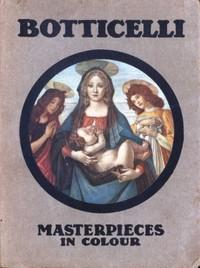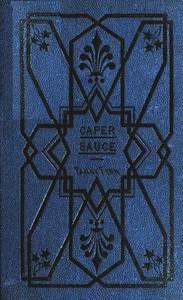|
|
Read this ebook for free! No credit card needed, absolutely nothing to pay.Words: 10257 in 3 pages
This is an ebook sharing website. You can read the uploaded ebooks for free here. No credit cards needed, nothing to pay. If you want to own a digital copy of the ebook, or want to read offline with your favorite ebook-reader, then you can choose to buy and download the ebook.

: Botticelli by Binns Henry Bryan - Botticelli Sandro 1444 or 5-1510 Masterpieces in Colour@FreeBooksWed 07 Jun, 2023 at of the Pollajuoli. His was a spirit yet more subtle than Sandro's own--subtle even with the subtlety of the serpent--and the two men must have understood one another intimately. Botticelli himself was a pleasant, even a jovial man, but a man of moods. Like Leonardo he never married. The frescoes were completed and the chapel opened in August 1483. Vasari tells how great renown, above that of all his fellows, in the work, Sandro gained in Rome, and what large sums he received and squandered there. Before settling again in his own city, he worked with Ghirlandajo upon the decorations of the Medici Villa at Volterra. From 1480 to 1490 he was probably regarded as the greatest of living masters in Florence, and was busy with many commissions. To this period belong several of his greatest works, probably the "Birth of Venus," greatest of them all, with the Madonnas of the Pomegranate and of St. Barnabas, certainly the Lemmi frescoes and the Bardi Madonna. Venus and the frescoes are in the perfect manner which characterises his classical subjects. The others are marked by some decline in technical handling. But in saying this, one must add that Sandro's work is, in all periods, amazingly unequal, alike in execution and conception. One almost wishes indeed that Vasari's dictum, that he worked "when he was minded," was even more true than it appears to be. For Sandro's subtle, wilful, whimsical genius hardly ever expressed its true nature in mere rivalry with other artists, or in the service of ecclesiastical patrons. Yet his undisputed works are too few, hardly fifty in all, for us really to wish any away. Even the panels of the St. Barnabas predella, and the tondo of the Ambrosiana Madonna can hardly be spared. Sandro, the poet-painter, was less happy than Pico della Mirandola, the beautiful marvellous youth, who had died at the beginning of these troubles wrapped in a friar's cloak, the beloved follower of the lion-hearted preacher. His own brother Simone, with whom he lived, was one of the Prate's followers, and suffered exile for his cause. There can be no doubt that he himself was profoundly influenced by Savonarola. After the tragedy of May 23, 1498, his workshop became a rendezvous for the many unemployed artists who had sympathised with the lost cause; and during the long evenings, those men would talk together of the dead days when "Christ was King of Florence." Sandro lived on for more than a decade, through evil days. Ghirlandajo had died in the same year as Pico, when Charles had entered the city: in 1504 his own pupil Filippino preceded him to the grave. The Pollajuoli were dead; Leonardo was but an occasional visitor, while Michael Angelo was dividing his time between Florence and Rome. In 1503 Botticelli was one of the artists consulted as to the position which should be allotted to the great sculptor's "David." He still shared some small property with his brother, but his principal patrons were dead, the times were out of joint, and he was seeking consolation in the study of Dante. A folio volume of drawings by his hand, illustrating the Divine Comedy, remains uncompleted; whether owing to the death of him for whom it was intended, or of the artist himself, we cannot tell. Sandro died on May 17, 1510, and was buried in All Saints. Probably painted about 1479, this is the most perfect example of Botticelli's circular pictures. The lines of the composition have been compared with those of the corolla of an open rose. The colour is rich and harmonious, and every detail exquisitely finished. The Virgin is still writing her song of the Magnificat, while the Child handles a symbolic pomegranate. The tondo is 44 inches in diameter. Botticelli was a Florentine in as intimate a sense as was Dante himself, and nowhere but in his native city can his work be fully appreciated. It is true that notable examples of his art have been carried away from time to time to other places, and that pictures attributed to him are still more widely scattered. New York has one of his most beautiful early works, the Madonna formerly belonging to Prince Chigi, for whose sale to America the unpatriotic Prince was heavily fined; St. Petersburg has an "Adoration of the Magi" belonging to Sandro's years in Rome. The "St. Sebastian" painted for Lorenzo has found its way to Berlin, where there is besides the Bardi Madonna; the badly damaged frescoes celebrating the wedding of Lorenzo Tornabuoni are at the head of a staircase in the Louvre; Rome has the Sixtine frescoes; Milan has two Madonnas; Bergamo has a panel; while our own National Gallery has five works, ranging from the earliest to the latest period. But it is in Florence that all but a small minority of Sandro's masterpieces are to be found, and it is in Florence that one first really comes under the spell of the magician. There, in the Uffizi, in the Sala de Lorenzo Monaco, in the holy company of Fra Angelico's saints and angels, is Sandro's masterpiece, "The Birth of Venus." It is a large canvas painted in tempera: but a horizontal join just apparent and running right across the picture, together with the medium used, gives it at first sight the appearance of being executed upon wood. It is in the pale cool colours of early morning, enriched by the heavy red of the robe which is about to embrace the wanderer's lovely form. There is a great sense of space behind her, over the grey sea. All about her the wind blows, making the light very clean and clear. She stands upon the edge of the great gleaming shell which has carried her, tilting it down with her weight as she leans forward to step ashore. Her figure, tall, slender, and quite central in the picture, feels the wind and light about it, but not shrinkingly. It floats and moves, yet without consciousness of movement, as it were a somnambulist moving across the sea. The pearly luminous quality of this living ethereal body, the heavy golden tresses of the long hair that hangs heavily against the wind, which with one hand she holds, while she lays the other dreamily on her breast, these are in the most perfect harmony with that flower-like immortal wistfulness which Sandro has put into her face. In striking contrast with this sea-born vision of Love, this strange visitant from an unknown world, stands the comparatively prosaic maiden who welcomes her and is about to wrap her in a rich mantle. This earth maiden, the representative of the Spring, in her pale gown sprigged with cornflowers, and her long plaits of dark hair, is garlanded, like the goddess in "Pallas and the Centaur," with olive branches. The curves of the mantle, which she holds out against the boisterous wind, make a delicious line that balances that of the "Venus." After the figure of the goddess, however, who really is no Venus, but rather the Muse of Sandro's art, the ideal of his aspirations--after her figure, the interest of the picture lies in the intricate whirl of living lines, of dark wings, pale limbs, and delicately coloured scarfs, with which Botticelli has symbolised the winds of Spring, stirring up the water with their feet and blowing the voyager on her way. A companion to the earlier tondo, this was probably not painted before Sandro's return from Rome, about the same time as the "Venus." It is broader in treatment and of more sombre colour than the "Magnificat." The eyes of the Child, who raises his hand in blessing, look straight out of the picture, in marked contrast to the attitude of the earlier work. There is a striking resemblance in many details, but the two pictures are quite distinct in character and feeling. This tondo measures 56 inches. Any attempt to convey by description the mystical significance of this decorative design would obviously be idle. Yet to miss that significance is to miss all. Regarded as the mere illustration of some verse of Politian's, or of Homer's hymn, the picture is open to endless criticism--the figure of Venus is out of drawing; the promontories, waves, and laurel trees are bare shorthand notes. It is when the spirit in the onlooker responds to the spirit entangled in the magical lines and tones and colours of the painting, that its indefinable beauty dawns upon him. You must love Botticelli's drawing if you are to understand it. In the same room hangs a smaller picture, very different in style, an "Adoration of the Kings"--a masterpiece too, and worthy of the closest study, but worlds removed from the "Venus." It is very highly and deliberately finished, and unlike its companion, belongs to the years before Sandro worked in Rome. It contains portraits of the Medicis and, more important to us, of the painter himself. Detached from the others he stands in the right-hand corner, under the peacock, wrapped in an orange mantle, gazing at us over his shoulder--a tall figure of a man with powerful enigmatic face. The composition of this picture, with its thirty figures and varied colouring, has been often and rightly praised. In spite of the clear individualisation of personalities and the elaboration of magnificent accessories, the unity and balance of design with its semi-circular grouping and the nobility and distinction of its lines, are well kept. If it was painted in rivalry with Ghirlandajo, for whose work it was at one time mistaken, it is marked by an intensity of realisation foreign to that worthy painter. These two pictures of the Sala di Lorenzo Monaco, the "Venus" and the "Adoration," are representative of the two realms in which Sandro worked; the one, of pure imagination, wedding Platonic ideas with a new conception of the possibilities of decorative art; the other, of the patrons and atmosphere of fifteenth-century Florence. Very few of his pictures belong exclusively to the one realm or the other, but to one or other belongs the influence which predominates in any one. Of the first class are notably the remaining works painted with classical motives. Foremost among these is the "Spring" of the Florence Academy, with its inimitable group of the Graces dancing in a marvellous rhythm of flowing intertwining lines, somewhat over-mannered, it is true, and with feeling a little forced, but yet of quite unique grace and intensity of conception. Much wordy debate over the literary signification of this painting has come between the vital meaning of the design and those who behold it. We may find suggestions in Lucian or Alberti, in Politian's or Lorenzo's verses, but as a work of art it derives only secondarily from any of these. It is a representation of beauty in a whimsical and even bizarre group of figures gleaming whitely under the dark trees between whose trunks shines the pale serene sky, while the grass through which their delicately modelled feet are moving is rich and full of flowers. This picture, in which the figures are nearly life size, while it has much in common with the "Venus," belongs to an earlier period, and is probably nearer in date to the "Adoration" already described, painted when the artist was about thirty-four years old. Some two years later he painted his "Pallas and the Centaur." The figure of the goddess, beautiful as it is, lacks something of the vitality and motion of the "Spring" and the "Venus"; perhaps the artist has given too much thought to the lovely wreathing of the symbolic olive boughs about her breast and arms and head; but on the other hand, the melancholy Centaur whom she leads by his heavy forelock is one of the most perfect expressions of his art. It is among the peculiar qualities of Sandro that he makes one feel, in looking at this picture, that it is one's own hand which grasps those dark curling locks; just as in the "Venus" one is conscious of the light and the wind falling upon one's own body. Behind the Centaur rises a mass of sculptured overhanging rocks, beyond lies a boat in the bay. Almost always there is some note of vista and distance in Botticelli's pictures. The colour of this large canvas is very pleasing. Pallas is clad in a loose green mantle and an under-robe of white adorned with the triple rings of the Medici; she is wreathed with olive, her auburn hair blows out behind her, and her feet are covered with a sort of orange buskin. Nothing could be finer than the contrast she presents with the dark, wild, pathetic figure of "Chaos and Old Night" whom she is leading captive. Free books android app tbrJar TBR JAR Read Free books online gutenberg More posts by @FreeBooks

: The Long Dim Trail by Hooker Forrestine C Forrestine Cooper - Western stories; Arizona Fiction; Cowboys Fiction; Ranch life Fiction@FreeBooksWed 07 Jun, 2023
|
Terms of Use Stock Market News! © gutenberg.org.in2025 All Rights reserved.






